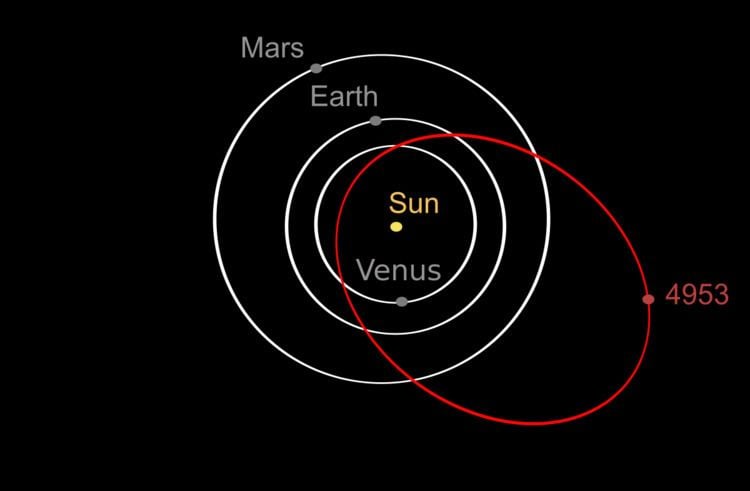Observation arc 15032 days (41.16 yr) Perihelion 0.55508 AU (83.039 Gm) Discovered 23 June 1990 Discoverer Robert H. McNaught | Discovery date 23 June 1990 Aphelion 2.6874 AU (402.03 Gm) Orbital period 754 days Orbits Sun | |
 | ||
Similar 4183 Cuno, 2201 Oljato, 3362 Khufu, 1865 Cerberus, 2212 Hephaistos | ||
(4953) 1990 MU is a large Earth-crossing asteroid (ECA) belonging to the Apollo family of asteroids which also cross the orbits of Mars and Venus. At approximately 3 km in diameter, it is one of the largest known ECAs. 1990 MU is the asteroid's temporary discovery name. It has now been assigned a permanent number from the Minor Planet Center (4953) indicating that its orbit has been confirmed, but has not (at least so far) been assigned a name. Only a small fraction of asteroids have been named.
1990 MU was first observed over three nights in 1990. By itself, this was not enough for the asteroid to be given a permanent number since the orbit could not be calculated accurately enough for the object to be subsequently recovered. However, the object was precovered by the Anglo-Australian Near-Earth Asteroid Survey on six photographic plates from the UK Schmidt Telescope dating back to 1974. This technique has more success with the Amor group of asteroids which do not cross the orbit of the Earth and consequently have long periods of opposition when they can be observed. In this respect the Apollo asteroid 1990 MU is somewhat unusual.
1990 MU has an Earth minimum orbit intersection distance (MOID) of 0.0276 AU (2,570,000 miles), which is close enough to classify it as a Potentially Hazardous Asteroid (PHA). It will make a close approach to Earth on 6 June 2027 at 0.0308 AU (2,870,000 miles), becoming as bright as apparent magnitude 8.7, and even closer on 5 June 2058 at 0.0231 AU (2,150,000 miles). It also made a close approach to Venus on 5 October 2012 at 0.0568 AU (5,280,000 miles) and will again on 3 September 2041 at 0.0581 AU (5,400,000 miles). 1990 MU has made close approaches to Earth in the past; in June 1996 it approached within 0.25 AU and in May 1990 it approached to 0.1418 AU. The Earth MOID of 1990 MU has been decreasing (becoming more hazardous) during the 20th century, while the Venus MOID (0.0455) has been increasing.
Besides its original discovery at Siding Spring Observatory in Australia, 1990 MU has also been studied by radar at Goldstone Observatory in California, and Arecibo Observatory in Puerto Rico. Lightcurves have been obtained at La Silla Observatory in Chile.
The albedo of 1990 MU was measured by the ExploreNEOs project of the Spitzer Space Telescope in August 2009. The result obtained was 0.79 and was the second highest albedo measured by the project. However, ExploreNEO do not believe this is a plausible figure, they state that the albedo of an NEO is not likely to be much over 0.5 and their measurement uncertainty is "around a factor of 2".
The Gaia mission of the European Space Agency, launched in December 2013, has been tasked with measuring the Yarkovsky effect on near-Earth asteroids (NEAs). The Yarkovsky effect is a small non-gravitational force on rotating bodies that can affect their trajectories. Its effect on small bodies like asteroids can be significant and needs to be taken into account in predicting an asteroid's position. 1990 MU has been selected as one of the most promising NEAs for this measurement by Gaia.
